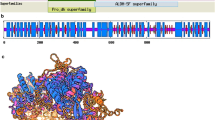Summary
The utilization ofd- andl -amino acids with acidic, basic or polar side chains was demonstrated by HPLC. Two species of the anaerobeFusobacterium utilized D-lysine and the L isomers of glutamate, glutamine, histidine, lysine and serine. OnlyF. varium usedl-arginine,d-glutamate andd-serine as substrates, whereasF. nucleatum specifically utilizedd-histidine andd-glutamine.d-Glutamate accumulated in F. nucleatum cultures supplemented withd-glutamine, and ornithine was detected when eitherdl- orl-arginine was included inF. varium cultures. Based on literature precedents,d-glutamate andd-histidine are isomerized to their L isomers prior to degradation, but separate catabolic pathways are possible for each enantiomer of lysine and serine.
Similar content being viewed by others
References
Abdelal AT (1979) Arginine catabolism by microorganisms. Ann Rev Microbiol 33: 139–168
Bakken V, Högh BT, Jensen HB (1989) Utilization of amino acids and peptides byFusobacterium nucleatum. Scand J Dent Res 97: 43–53
Barker HA (1999) Fermentations of nitrogenous organic compounds. In: Gunsalus IC, Stanier RY (eds) The bacteria, vol 2: Metabolism. Academic Press, New York, pp 451–207
Barker HA (1981) Amino acid degradation by anaerobic bacteria. Ann Rev Biochem 50: 23–40
Barker HA, Kahn JM, Hedrick L (1982) Pathway of lysine degradation inFusobacterium nucleatum. J Bacteriol 152: 201–207
Bugg TDH, Walsh CT (1992) Intracellular steps of bacterial cell wall peptidoglycan biosynthesis: enzymology, antibiotics, and antibiotic resistance. Nat Prod Rep 9: 199–215
Dzink JL, Socransky SS (1990) Amino acid utilization byFusobacterium nucleatum grown in a chemically defined medium. Oral Microbiol Immunol 5: 172–174
Gharbia SE, Shah HN (1989) The uptake of amino acids from a chemically defined medium byFusobacterium species. Curr Microbiol 18: 189–193
Gharbia SE, Shah HN (1991) Comparison of the amino acid uptake profile of reference and clinical isolates ofFusobacterium nucleatum subspecies. Oral Microbiol Immunol 6: 264–269
Gharbia SE, Shah HN, Welch SG (1989) The influence of peptides on the uptake of amino acids in Fusobacterium; predicted interactions withPorphyromonas gingivalis. Curr Microbiol 19: 231–235
Hecht K, Zhang S, Klopotowski T, Ames GF-L (1996) D-Histidine utilization inSalmonella typhimurium is controlled by the leucine-responsive regulatory protein (Lrp). J Bacteriol 178: 327–331
Jackins HC, Barker HA (1951) Fermentative processes of the fusiform bacteria. J Bacteriol 61: 101–114
Kisumi M, Kato J, Chibata I (1964) Studies on the isoleucine fermentation 111. The incorporation ofd-threonine-2-C14 and uniformly labeled glucose-C14 into isoleucine. J Biochem 56: 450–456
Kuhn J, Somerville RL (1971) Mutant strains ofEscherichia coli K12 that used-amino acids. Proc Natl Acad Sci USA 68: 2484–2487
Lam S (1986) Resolution ofd- andl-amino acids after precolumn derivatization with ophthalaldehyde by mixed chelation with CU(II)-l-proline. J Chromatogr 355: 157–164
Lawson PA, Gharbia SE, Shah HN, Clark DR, Collins MD (1991) Intrageneric relationships of members of the genusFusobacterium as determined by reverse transcriptase sequencing of small-subunit rRNA. Int J Syst Bacteriol 41: 347–354
Loesche WJ, Gibbons RJ (1968) Amino acid fermentation byFusobacterium nucleatum. Arch Oral Biol 13: 191–201
Markovetz AJ, Cook WJ, Larson AD (1966) Bacterial metabolism ofd-aspartate involving racemization and decarboxylation. Can J Microbiol 12: 745–751
McFall E, Newman EB (1996) Amino acids as carbon sources. In: Neidhardt FC (ed)Escherichia coli andSalmonella: cellular and molecular biology, 2nd edn. ASM Press, Washington, pp 358–379
McInerney MJ (1988) Anaerobic hydrolysis and fermentation of fats and proteins. In: Zehnder AJB (ed) Biology of anaerobic microorganisms. John Wiley & Sons, New York, pp 373–415
Meister A (1965) Biochemistry of the amino acids, 2nd edn. Academic Press, New York, pp 460–473
Ramezani M (1996) Catabolism of amino acids byFusobacterium species. PhD Thesis, Dalhousie University
Robrish SA, Oliver C, Thompson J (1987) Amino acid-dependent transport of sugars byFusobacterium nucleatum ATCC 10953. J Bacteriol 169: 3891–3897
Rogers AIL Zilm PS, Gully NJ, Pfennig AL, Marsh PD (1991) Aspects of the growth and metabolism ofFusobacterium nucleatum ATCC 10953 in continuous culture. Oral Microbiol Immunol 6: 250–255
Rydon HN (1948) D-Amino-acids in microbiological chemistry. Biochem Soc Symp 1: 4060
Shah HN, Gharbia SE (1989) Ecological events in subgingival dental plague with reference toBacteroides andFusobacterium species. Infection 17: 264–268
Shah HN, Gharbia SE, Zhang MIN (1993) Measurement of electrical bioimpedance for studying utilization of amino acids and peptides byPorphyromonas gingivalis, Fusobacterium nucleatum, andTreponema denticola. Clin Infect Dis 16 [Suppl] 4: S404-S407
Stadtman TC (1973) Lysine metabolism by clostridia. Adv Enzymol 38: 413–448
Tanaka M, Mukohata Y, Yuasa S (1996) Utilization ofd-leucine byHalobacterium halobium V0107. Can J Microbiol 42: 973–976
Tsuda Y, Friedmann HC (1970) Ornithine metabolism byClostridium sticklandii. J Biol Chem 245: 5914–5926
Ushijima T (1992) Comparison of amino acid utilization of colonic bacteria and enteropathogenic bacteria in anaerobic static cultures. Igaku to Seibutsugaku 125: 201–206; Chem Abstr (1993) 118: 120658x
White RL, DeMarco AC, Smith KC (1989) Analysis ofo-phthalaldehyde derivatives of acidic and polar amino acids in fermentation broths by high-performance liquid chromatography. J Chromatogr 483: 437–442
White RL, Smith KC, DeMarco AC (1994) Biosynthesis of 5-hydroxy-4-oxo-l-norvaline inStreptomyces akiyoshiensis. Can J Chem 72: 1645–1655
White RL, Ramezani M, Gharbia SE, Seth R, Doherty-Kirby AL, Shan HN (1995) Stable-isotope studies of glutamate catabolism inFusobacterium nucleatum. Biotechnol Appl Biochem 22: 385–396
Author information
Authors and Affiliations
Rights and permissions
About this article
Cite this article
Ramezani, M., MacIntosh, S.E. & White, R.L. Utilization ofd-amino acids byFusobacterium nucleatum andFusobacterium varium . Amino Acids 17, 185–193 (1999). https://doi.org/10.1007/BF01361881
Received:
Accepted:
Issue Date:
DOI: https://doi.org/10.1007/BF01361881




